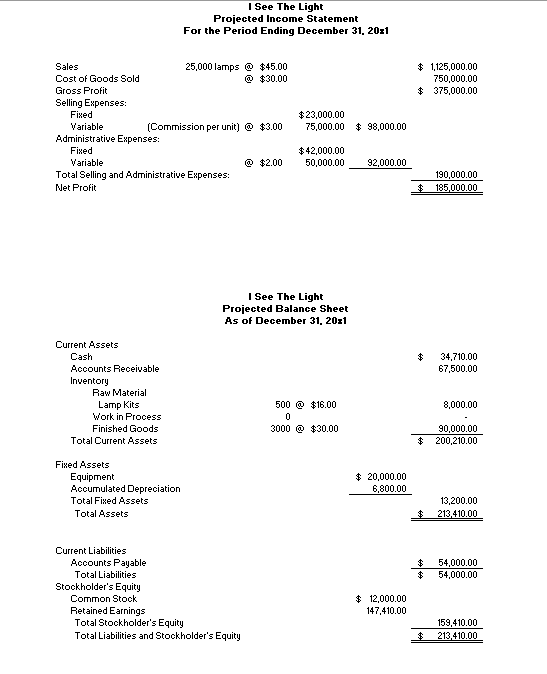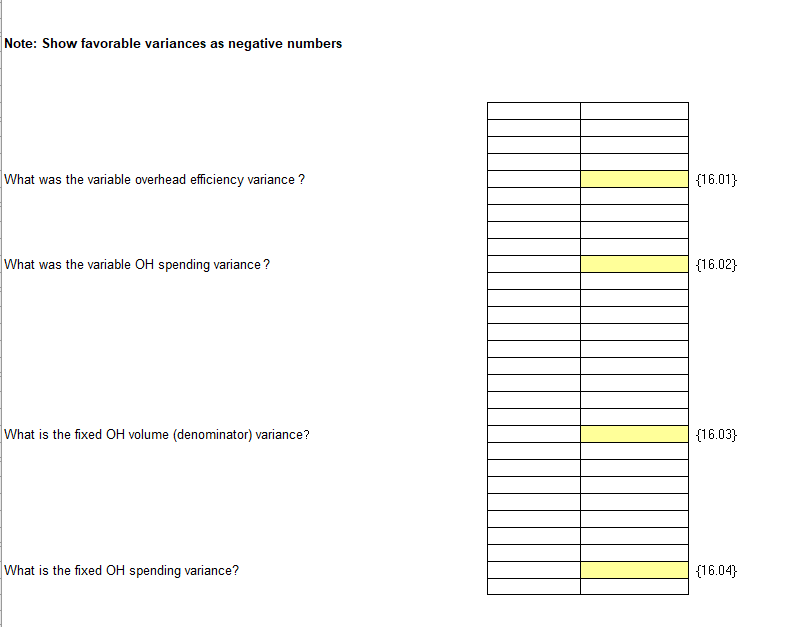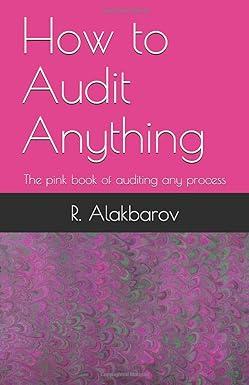Answered step by step
Verified Expert Solution
Question
1 Approved Answer
Please let me know if any more info is needed. Thank you! I See The Light Projected Income Statement For the Period Ending December 31,




Please let me know if any more info is needed. Thank you!
I See The Light Projected Income Statement For the Period Ending December 31, 2021 $ 1,125,000.00 750,000.00 $ 375,000.00 Sales 25,000 lamps @ $45.00 Cost of Goods Sold @ $30.00 Gross Profit Selling Expenses: Fixed Variable (Commission per unit) $3.00 Administrative Expenses: Fixed Variable @ $2.00 Total Selling and Administrative Expenses: Net Profit $23,000.00 75,000.00 $ 98,000.00 $ 42,000.00 50,000.00 92,000.00 190,000.00 $ 185,000.00 I See The Light Projected Balance Sheet As of December 31, 2021 $ 34,710.00 67,500.00 Current Assets Cash Accounts Receivable Inventory Raw Material Lamp Kits Work in Process Finished Goods Total Current Assets 8,000.00 500 @ $16.00 0 3000 @ $30.00 $ 90,000.00 200,210.00 Fixed Assets Equipment Accumulated Depreciation Total Fixed Assets Total Assets $ 20,000.00 6,800.00 13,200.00 213,410.00 $ $ 54,000.00 54,000.00 Current Liabilities Accounts Payable Total Liabilities Stockholder's Equity Common Stock Retained Earnings Total Stockholder's Equity Total Liabilities and Stockholder's Equity $ 12,000.00 147,410.00 159.410.00 213.410.00 PART 6 Standard Job Order Costing - Variance Analysis Special order lamps are manufactured in division S. Because of the precise nature of the process a standard cost system has been developed. The following standards are used for the special orders: Standards Lamp Kits Direct Labor Variable Overhead ** Fixed Overhead Total $16.000000 per lamp 2.400000 per lamp (4 lampshr.) 0.250000 per lamp (4 lampshr.) 10.000000 per lamp $28.650000 ** Fixed overhead is based on expected production of 4,005 customized lamps each month. To keep records of the actual cost of a job, a Job Order Cost System has been developed. Entries are made to the Job Order System at actual cost (overhead is applied based on actual labor hours) while entries are made to the accounting system at standard. Variance analysis is used to analyze the differences. Job Order Costing Section On January 1, 20x2. Division S began Job 1101 for the Client, THE BIG CHILDREN STORE. The job called for 4,000 customized lamps. The following set of transactions occurred from January 5 until the job was completed: 5-Jan Purchased 4,025 Lamp Kits @ $16.65 per kit. 9-Jan 4,075 sets of Lamp Kits were requisitioned. 17-Jan Payroll of 590 Direct Labor Hours @ $9.80 per hour. 30-Jan Payroll of 640 Direct Labor Hours @ $10.05 per hour. 30-Jan 3,995 lamps were completed and shipped. All materials requisitioned were used or scrapped. MvEn/w/1437/htiv Actual Variable Overhead Actual Fixed Overhead $ 1,451.40 $ 40,123.45 How many Lamps were completed? Note: Show favorable variances as negative numbers two places, $##.## What was the total material price variance for the Lamp Kits purchased? (15.01) What was the material usage variance for Lamp Kits? {15.02) What was the direct labor efficiency variance ? (15.03) What was the direct labor rate variance? {15.04) Note: Show favorable variances as negative numbers What was the variable overhead efficiency variance ? {16.01} What was the variable OH spending variance? {16.02} What is the fixed OH volume (denominator) variance? {16.03} What is the fixed OH spending variance? (16.04)Step by Step Solution
There are 3 Steps involved in it
Step: 1

Get Instant Access to Expert-Tailored Solutions
See step-by-step solutions with expert insights and AI powered tools for academic success
Step: 2

Step: 3

Ace Your Homework with AI
Get the answers you need in no time with our AI-driven, step-by-step assistance
Get Started


